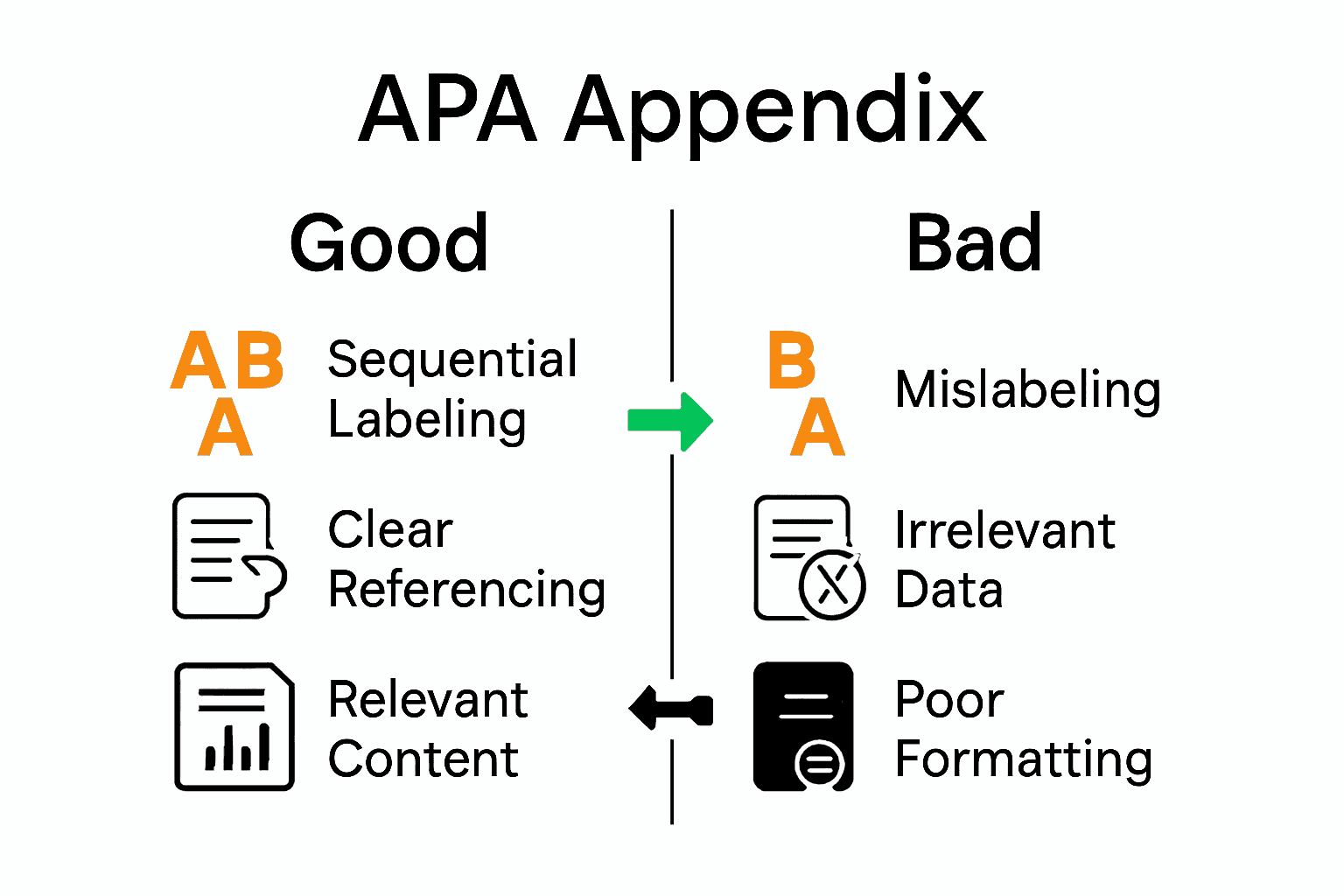Blog
Learning Materials
APA Style Appendix Explained: Formatting and Best Practices
Updated: October 21, 2025

Did you know that over 60 percent of academic papers include at least one appendix to present extra data or resources? This section plays a key role in keeping research papers clear and organized. Understanding the purpose and format of an appendix helps you share essential details without cluttering your main argument, making your research both thorough and easy for readers to follow.
Key Takeaways
| Point | Details |
|---|---|
| Purpose of Appendix | An appendix supplements research papers by providing additional context without disrupting the main narrative. |
| Types of Appendices | Common types include numerical (data), textual (interviews), and visual (charts) to enhance understanding. |
| Formatting Guidelines | Appendices should begin on a new page, be labeled sequentially, and follow APA style for clarity and consistency. |
| Common Mistakes | Avoid including irrelevant materials and ensure proper referencing and formatting to maintain professionalism. |
Table of Contents
- Defining An Apa Style Appendix In Research
- Types Of Appendices And Sample Materials
- Step-By-Step Formatting And Labeling Rules
- How To Reference Appendices In-Text
- Common Appendix Mistakes To Avoid
Defining an APA Style Appendix in Research
An appendix represents a supplementary section in academic research that provides additional context, detailed data, or supporting materials that enhance but do not disrupt the primary narrative flow of a research paper. According to research from Santa Clara University, an appendix contains material that belongs with the paper rather than directly within it, typically appearing at the document's very end.
Research appendices can include a wide range of supplemental content such as raw data tables, extended research methodologies, questionnaires, interview transcripts, statistical calculations, or complex visual representations that would otherwise clutter the main text. Each individual appendix must be clearly referenced within the main body of the research paper, ensuring that readers understand its relevance and can locate the additional information seamlessly.
The strategic placement of appendices allows researchers to provide comprehensive evidence and transparency without overwhelming readers with excessive technical details in the primary manuscript. By separating supplementary materials, authors maintain a clean, focused narrative while still offering interested readers access to more in-depth supporting information. When creating an appendix, researchers should ensure each supplemental document is clearly labeled, numbered sequentially, and formatted according to precise APA style guidelines.
For researchers seeking to master the nuanced art of crafting professional academic documents, understanding how to effectively integrate and format appendices is crucial. Our comprehensive guide on research paper citation can provide additional insights into maintaining academic writing standards.
Types of Appendices and Sample Materials
According to research from Franklin University, appendices encompass a diverse range of supplemental materials that provide critical context and detailed information beyond the primary research narrative. These supplementary documents can include complex academic resources such as mathematical proofs, comprehensive word lists, detailed research questionnaires, extensive apparatus descriptions, and other technical content that would disrupt the main paper's flow if integrated directly.
Researchers typically organize appendices into several distinct categories based on their content and purpose.
Here's a summary of common types of research appendices:
| Appendix Type | Typical Contents | Purpose |
|---|---|---|
| Numerical | Raw data tables Statistical analyses | Present detailed calculations and data |
| Textual | Interview transcripts Survey forms | Provide full text research materials |
| Visual | Charts Diagrams Photographs | Illustrate methodology or findings |
The strategic selection of appendix materials requires careful consideration. Each supplemental document must directly relate to the research, provide meaningful additional information, and maintain strict APA formatting guidelines.
 Researchers should critically evaluate whether the material enhances understanding, offers transparency in research processes, or provides essential supporting evidence that cannot be effectively summarized in the main text.
Researchers should critically evaluate whether the material enhances understanding, offers transparency in research processes, or provides essential supporting evidence that cannot be effectively summarized in the main text.
For academic writers seeking to master the nuanced art of creating comprehensive research documents, our guide on appendices for research papers offers expert strategies to effectively integrate and format these critical supplementary materials.
Step-by-Step Formatting and Labeling Rules
According to research from the University of Southern California, APA appendix formatting follows a precise set of guidelines that ensure consistency and clarity in academic research documents. Appendices must always begin on a new page immediately following the references and any footnotes. When multiple appendices are included, they are systematically labeled to provide clear organization and easy navigation for readers.
The labeling process follows a specific hierarchy. If only one appendix is present, it is simply labeled as "Appendix." When multiple appendices are used, they are assigned sequential uppercase letters (Appendix A, Appendix B, etc.). The content within each appendix should be organized strategically - typically starting with text materials, followed by tables, and then figures. Each item within an appendix is numbered using a combination of the appendix letter and a sequential number, creating a clear and logical referencing system.
Researchers must pay careful attention to formatting details. Labeling conventions are particularly important when an appendix consists solely of a table or figure. In such cases, the appendix label completely replaces the traditional table or figure title. This means that instead of a typical table title, you would use something like "Appendix A" or "Appendix B, Table 1." Additionally, each appendix should maintain consistent formatting, including standard margins, font type and size, and double-spacing throughout the document.
For those looking to refine their academic writing skills, our tutorial on writing essay in APA format can provide additional insights into maintaining precise academic documentation standards.
How to Reference Appendices In-Text
Referencing appendices within the main text requires precision and careful attention to detail. When you want to direct readers to supplemental information, you'll need to explicitly mention the specific appendix and its location. This means providing a clear parenthetical reference that guides readers exactly where to find the additional supporting materials.
The standard approach involves mentioning the appendix directly in your sentence, followed by a parenthetical reference. For instance, you might write: "Detailed survey results can be found in Appendix A" or "(see Appendix B for complete research instruments)". If you're referencing a specific table, figure, or component within an appendix, you would use a more detailed citation like "(Appendix C, Table 2)" or "(see Appendix D, Figure 3)". This approach ensures that readers can quickly and easily locate the supplementary information you're discussing.
Academic writing demands consistency in how these references are formatted. Every in-text reference to an appendix should be clear, direct, and unambiguous. If you have multiple appendices, use precise lettering (Appendix A, Appendix B) to avoid any confusion. Remember that the goal is to provide seamless navigation for your readers, allowing them to effortlessly move between the main text and supplementary materials without disrupting the flow of your research narrative.
For researchers looking to refine their academic writing skills, our comprehensive guide on research paper citation offers additional insights into maintaining professional documentation standards.
Common Appendix Mistakes to Avoid
According to research from Franklin University, one of the most critical pitfalls in academic writing is including irrelevant or non-essential material in appendices. Researchers must exercise careful judgment, recognizing that appendices should contain only supportive information that enhances the understanding of the research without distracting from the main narrative. This means critically evaluating each piece of supplementary material to ensure it truly adds value to the academic work.
Several common mistakes can undermine the effectiveness of appendices. Overloading appendices with excessive or redundant information is a frequent error that can confuse readers and diminish the impact of your research. Researchers often make the mistake of including raw data or lengthy materials that could be more effectively summarized or condensed. Another critical error is failing to properly reference appendices within the main text, which can leave readers struggling to understand the connection between the primary content and supplementary materials.

Formatting and organization are equally important considerations. Inconsistent formatting, improper labeling, or poor organization can significantly reduce the professionalism and readability of your appendices. This includes using incorrect numbering systems, failing to maintain consistent font and margin requirements, or presenting materials in a way that makes navigation difficult. Additionally, researchers should avoid treating appendices as a dumping ground for miscellaneous information. Each appendix should have a clear purpose and directly support the research's main arguments or methodological approach.
For academic writers seeking to refine their documentation skills, our guide on appendices for research papers offers expert strategies to help you avoid these common pitfalls and create professional, meaningful supplementary materials.
Transform Your APA Appendix Formatting With Smart Tools
Struggling to organize appendices, fix those tricky references, or maintain perfect APA style? Many writers feel overwhelmed when formatting supplementary sections and ensuring every table, figure, or transcript fits the guidelines. These challenges can make any research paper frustrating and time-consuming, especially when precise documentation and seamless navigation matter most.

Take control of your next submission with Samwell.ai. Our platform is built to help you solve common pain points such as inconsistent labeling, incorrect in-text citations, and the stress of managing APA compliance. Use guided templates, a powerful editor, and a research citation guide for flawless appendix organization. Start now to enhance your academic writing and boost your confidence at every stage. Ready to deliver a paper that stands out? Visit Samwell.ai and make perfect appendices a reality.
Frequently Asked Questions
What is the purpose of an appendix in APA style?
An appendix in APA style serves as a supplementary section that provides additional context, data, or supporting materials that enhance the main narrative of a research paper without overwhelming the reader.
What kind of content can be included in an APA appendix?
An APA appendix can include a variety of materials such as raw data tables, detailed questionnaires, interview transcripts, statistical calculations, and complex visual representations that support the research but do not fit seamlessly into the main text.
How should I format my appendices in APA style?
Each appendix must start on a new page and be labeled sequentially (Appendix A, Appendix B, etc.). The content should maintain consistent formatting, including font size, double-spacing, and margin settings, following APA style guidelines.
How do I reference an appendix in the main body of my paper?
To reference an appendix in your paper, mention it directly in your text along with a parenthetical reference, such as "(see Appendix A)" or "Appendix B contains the survey results." This helps guide readers to the supplementary information easily.
Generate essays with Samwell.ai
Whether you’re a publisher, professor, journalist, or student, let us tailor a plan just for you.Most Read Articles

Your Guide to Help Writing a Essay Successfully
Expert tips for help writing a essay - from crafting a thesis to structuring your essay effectively.

How to Write Critical Thinking Essay: Expert Tips
Expert tips for writing a critical thinking essay. Learn how to structure, choose topics, and use evidence effectively.'

How to Write a Good Hook: A Step-by-Step Guide
Master the art of crafting a good hook with our guide. Create compelling openers for a memorable first impression.
